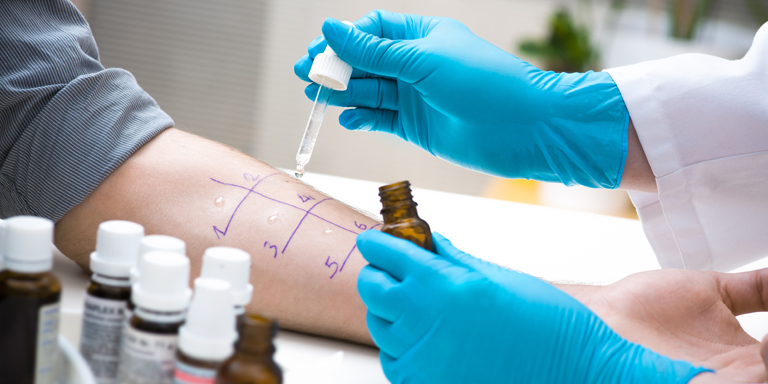Allergy tests
Different allergy tests can be carried out to identify what allergens the immune system reacts to.

Table of contents:
When the immune system overreacts to substances in the environment that are harmless in themselves - such as pollen, house dust mites or food - then this is known as an allergy. The number of sufferers around the world has increased sharply in recent years.
Why is an allergy test necessary?
It is important to identify the allergen in order to take the correct preventive measures and avoid the allergen effectively. Immunotherapy – i.e. desensitisation – requires an accurate and current diagnosis beforehand.
Who carries out allergy tests?
This depends on the test. Skin tests should be performed solely by allergy specialists. Interpretation of an allergy test is the most difficult part and requires experience. Whereas a simple blood sample is required for the blood test, the patient in a provocation test needs to be kept under medical observation.
How informative is an allergy test?
There is no totally reliable test method for diagnosing allergies, which is why the experience of a professional is required. Any allergy test must be preceded by a thorough interview (medical history) to obtain information about symptoms, the disease course of the allergy, the family incidence of allergies and previous treatment methods. The allergy tests are interpreted in conjunction with all this information.
How does a skin test work?
A distinction is made between skin tests to detect immediate-type and delayed-type reactions. Skin tests are relatively simple to perform and are not painful. When detecting an immediate-type reaction, various allergen solutions are dropped onto the skin of the forearm and pricked with a fine needle (prick test) so that the allergen comes into contact with the skin cells. The test reaction is assessed after 20 minutes. A positive reaction looks like a mosquito bite. With delayed-type reactions, a patch is fixed onto the back and the reaction - usually a small area of eczema - is assessed after one or two days.
How does a blood test work?
The blood test is done in the laboratory, where the blood is tested specifically for antibodies (specific IgE) to individual allergens. The doctor or allergy specialist interprets the results alongside the respective patient’s medical history. The blood test can be performed at any age and regardless of whether the patient has already taken any medication (e.g. an antihistamine). There are more than 500 different allergens available for testing. These are always a mixture of different allergen fragments (epitopes). It is possible to test for individual proteins of a whole allergen (e.g. birch pollen). The individual’s specific sensitisation pattern is crucial when planning an allergen- specific immunotherapy. At the same time, it can also help identify any cross-reaction, e.g. if allergic reactions to hazelnuts and apples are known in addition to a pollen allergy. For those with food allergies, the sensitisation pattern may sometimes provide information about the severity of the reactions.
How does a provocation test work?
In a provocation test, the allergen is administered either orally, by inhalation or by direct contact with the skin or mucous membrane. The provocation allows the symptoms to be monitored and triggered while the patient is under observation. This test should only be performed by specialised doctors and allergy specialists. This test also helps determine whether someone with a food allergy can consume food containing traces of the allergen.
Editors: aha! Swiss Allergy Centre in co-operation with the Scientific Advisory Board.





